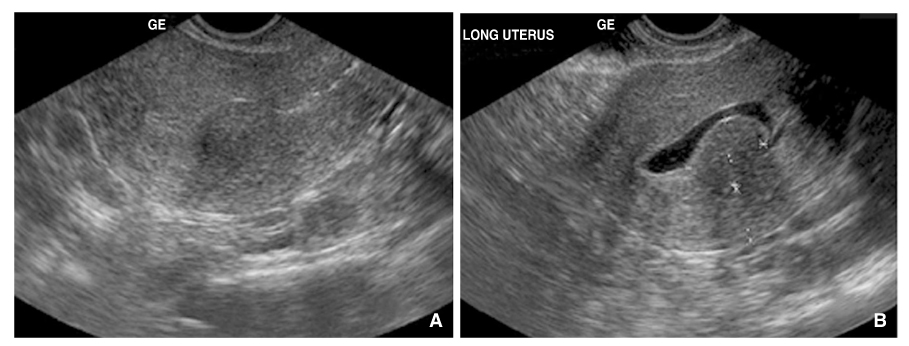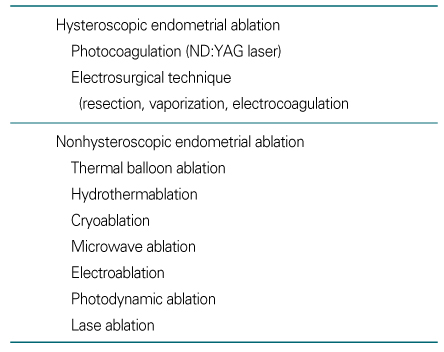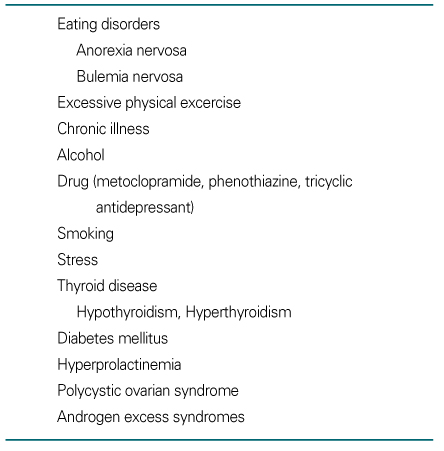 |
 |
- Search
| J Korean Med Assoc > Volume 49(10); 2006 > Article |
Abstract
The average length of menstrual cycle is 28 days, and duration of flow is 4 days, and an average blood loss is 35cc. Abnormal uterine bleeding is defined as bleeding at abnormal or unexpected times or by an excessive flow at the time of expected menses. Any bleeding should be considered abnormal in premenarchal girls and in postmenopausal women. The etiology of abnormal uterine bleeding encompasses a wide range of disorders that can be secondary to pregnancy-related disorders, anatomic changes of the female genital tract, infection, endocrinologic disorders, malignancies, and systemic illnesses. Dysfunctional uterine bleeding (anovulatory or ovulatory) is diagnosed by exclusion of these causes. An appropriate workup is guided by age-related differential diagnoses for abnormal bleeding. Modern diagnostic tools can readily reveal the underlying pathology and allow timely intervention. Most abnormal genital tract bleeding occurs in the form of uterine bleeding, which is one of the most common gynecologic problems that health care providers encounter with, accounting for approximately 19% of office visits and 25% of gynecologic operations. The author will review the categories of abnormal uterine bleeding and the diagnostic tools needed to establish the correct diagnosis and treatment strategy.
References
1. Speroff L, Fritz MA. Clinical gynecologic endocrinology and infertility 2005;7th ed. Baltimore: Lippincott Williams & Wilkins. 549.
2. Haynes PJ, Hodgson H, Anderson AB, Turnbull AC. Measurement of menstrual blood loss in patients complaining of menorrhagia. Br J Obstet Gynaecol 1977;84:763.
3. Goodman A. Abnormal genital tract bleeding. Clin Cornerstone 2000;3:25-35.
4. American Medical Association. Diagnostic and treatment guidelines on child sexual abuse 1992;Chicago: American Medical Association.
5. Herman-Giddens ME. Vaginal foreign bodies and child sexual abuse. Arch Pediatr Adolesc Med 1994;148:195-200.
6. Anveden-Hertzberg L, Gauderer MW, Elder JS. Urethral prolapse: an often misdiagnosed cause of urogenital bleeding in girls. Pediatr Emerg Care 1995;11:212-214.
7. Herman-Giddens MF, Slora EJ, Wasserman RC. Secondary sexual characteristics and menses in young girls seen in office practice: a study from the Pediatric Research in Office Settings network. Pediatrics 1997;99:505-512.
8. World Health Organization Task Force on Adolescent Reproductive Health. Longitudinal study of menstrual patterns in the early postmenarchal period, duration of bleeding episodes and menstrual cycles. J Adolesc Health Care 1986;7:236-244.
9. Slap GB. Menstrual disorders in adolescence. Best Pract Res Clin Obstet Gynaecol 2003;17:75-92.
10. Burke AE, Blumenthal PD. Successful use of oral contraceptives. Semin Reprod Med 2001;19:313-321.
11. Rosenberg MJ, Burnhill MS, Waugh MS. Compliance and oral contraceptives: a review. Contraception 1995;52:137-141.
12. Oakley D, Sereika S, Bogue EL. Oral contraceptive pill use after an initial visit to a family planning clinic. Fam Plann Perspect 1991;23:150-154.
13. Balassone ML. Risk of oral contraceptive discontinuation among adolescents. J Adolesc Health Care 1989;10:527-533.
14. Clawssens EA, Cowell CA. Acute adolescent menorrhagia. Am J Obstet Gynecol 1981;139:277-280.
15. Centers for Disease Control And Prevention. 1998 guidelines for treatment of sexually transmitted diseases. MMWR Recomm Rep 1998;47:1-111.
16. Stewart EA, Nowak RA. Leiomyoma related bleeding: a classic hypothesis updated for the molecular era. Hum Reprod Update 1996;2:295-306.
17. Prentice A. In: Smith SK, editor. Healthcare implications of dysfunctional uterine bleeding London: Bailiere Tindall. 181-188.
18. Van Eijkeren MA, Christiaens GCML, Sixma JJ. Menorrhagia: a review. Obstet Gynecol Surv 1989;4:421-429.
19. Hoffman GE, Rao CV, DeLeon FD. Human endometrial prostaglandin E2 binding sites and their profiles during the menstrual cycle and in pathological states. Am J Obstet Gynecol 1985;151:369-375.
20. Smith SK, Abel MH, Kelly RW, Baird DT. Prostaglandin synthesis in the endometrium of women with ovular dysfunctional uterine bleeding. Br J Obstet Gynaecol 1981;88:434-442.
21. Makarainen L, Ylikorala O. Primary and myoma associated menorrhagia: role of prostaglandins and effects of ibuprofen. Br J Obstet Gynaecol 1986;93:974-978.
22. Cameron IT, Campbell S. Nitric oxide in the endometrium. Hum Reprod Update 1998;4:565-569.
23. Lethaby A, Farquhar C, Cooke I. Antifibrinolytics for heavy menstrual bleeding (Cochrane Review). The Cochrane Library 2002;vol. 4:Oxford: Update Software.
24. Lindoff C, Rybo G, Astedt B. Treatment with tranexamic acid during pregnancy, and the risk of thrombo-embolic complications. Thromb Haemost 1993;70:238-240.
25. Lethaby A, Augood C, Duckitt K. Nonsteroidal anti-inflammatory drugs for heavy menstrual bleeding (Cochrane Review). The Cochrane Library vol. 4:Oxford: Update Software 2002.
26. Iyer V, Farquhar C, Jepson R. Oral contraceptive pills for heavy menstrual bleeding (Cochrane Review). The Cochrane Library 2002;vol. 4:Oxford: Update Software.
27. French RS, Cowan FM, Mansour D, Higgins JPT, Robinson A, Procter T, et al. Levonorgestrel-releasing (20 microgram/day) intrauterine systems (Mirena) compared with other methods of reversible contraceptives. BJOG 2000;107:1218-1225.
28. Lethaby AE, Cooke I, Rees M. Progesterone/progestogen releasing intrauterine systems for heavy menstrual bleeding (Cochrane Review). The Cochrane Library 2002;vol.4:Oxford: Update Software.
29. Lethaby A, Hickey M, Garry R. Endometrial destruction techniques for heavy menstrual bleeding (Cochrane Review). The Cochrane Library 2006;Issue 3.
30. Malcolm G, Munro . Abnormal uterine bleeding: surgical management-part III. J Am Assoc Gynecol Laparosc 2001;8:18-44.
31. Munro Malcolm G. Abnormal uterine bleeding in the reproductive years: medical management-part III. J Am Assoc Gynecol Laparosc 2000;7:19-32.
32. Munro Malcolm G. Dysfunctional uterine bleeding: advances in diagnosis and treatment. Curr Opin Obstet Gynecol 2001;13:475-489.
33. Berek JS. Novak's Gynecology 2002;13th ed. Philadelphia: Lippincott Williams & Wilkins. 371.
34. Goldstein SR. Menorrhagia and before the menopause. Best Practice & Research Clinical Obstetrics 2004;181:59-69.
35. Moodley M, Roberts C. Clinical pathway for the evaluation of postmenopausal bleeding with an emphasis on endometrial cancer detection. J Obstet Gynaecol 2004;24:736-741.
Figure 1
Sequential steps through the differential diagnosis of abnormal uterine bleeding in women of childbearing age
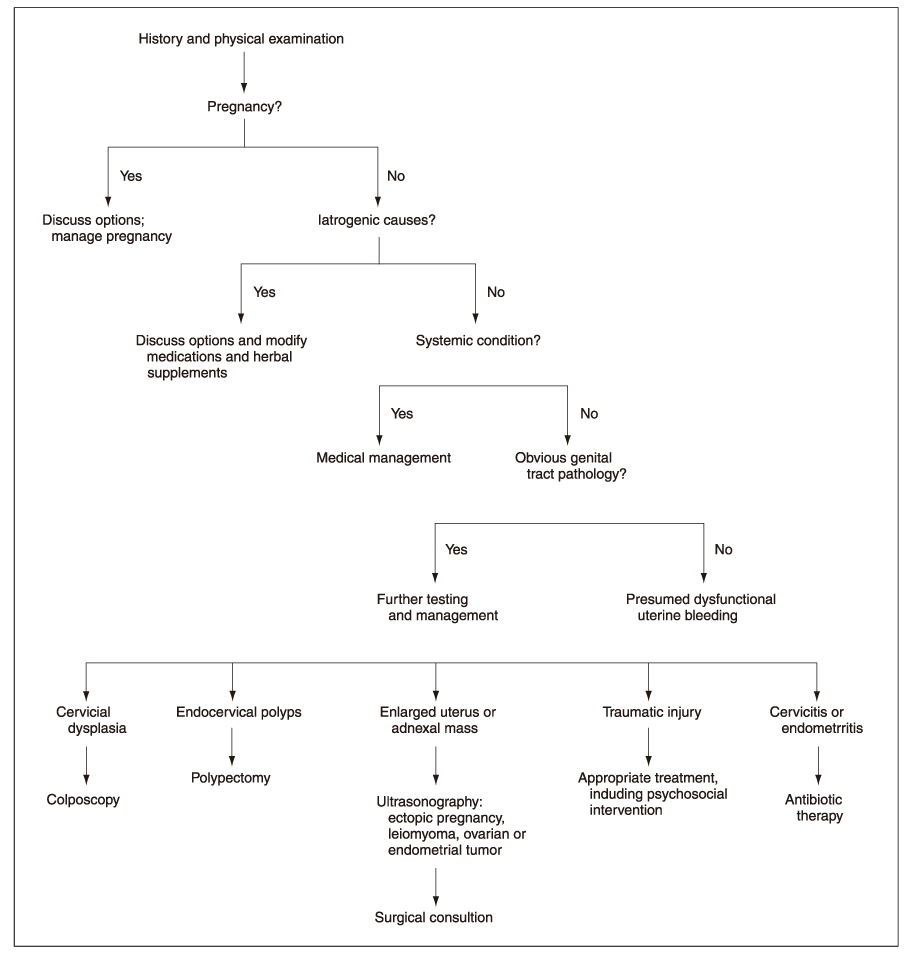
Figure 2
Menstrual record. (from Iglesias E, Coupey S. Menstrual cycle abnormalities: diagnosis and management. Adolesc Med 1999; 10: 259)
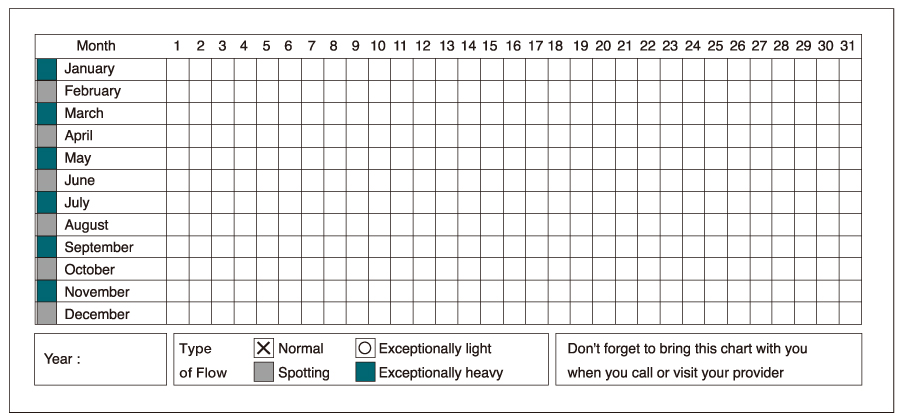
- TOOLS
-
METRICS

-
- 1 Crossref
- Scopus
- 1,100 View
- 1 Download
-
Related articles in
J Korean Med Assoc -
Dysfunctional Uterin Bleeding(DUB) in Adolescents1998 July;41(7)




